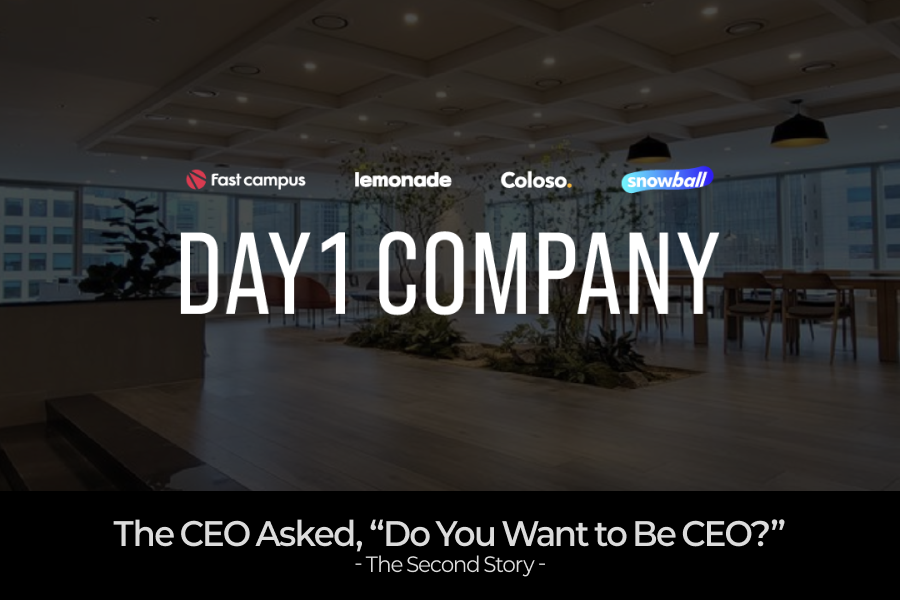Why Does a Startup Need Five CEOs? – (2)

Stepping Back to See the Bigger Picture
A few new ventures were attempted, then quickly dropped. I even considered acquiring a company, but none of the options felt right. It seemed as though time was slipping away without any meaningful contribution to the business. Ironically, what I thought would bring relief actually led to an even more challenging period. Who knew maintaining one’s self-esteem could be this difficult?
To clear my head, I reflected on the journey so far. Back in 2014, a small group of fresh graduates came together to start what felt like a college club. Since then, the company had doubled in size year after year, with exponential growth. A business that began with offline education seamlessly transitioned online, accelerating its momentum. Our old office, which was once in a musty, dimly lit basement, was now in a sleek building so iconic it had a subway stop named after it. In just eight years, DAY1COMPANY had reached ₩100 billion in cumulative sales, employing hundreds. I couldn’t help but think back to the days of battling just to survive, and suddenly, the company felt like a rocket that had been launched into the sky. Like a spacecraft shedding its first-stage booster after breaking through the atmosphere, DAY1COMPANY had reached a point where it needed more than just propulsion to move forward—it needed precision to land in the right orbit.
Suddenly, the path ahead became clearer. Each CIC leader was a young, dynamic leader in their 20s and 30s, rapidly achieving success while showcasing distinct strengths and weaknesses. I realized my role now was to support their growth. While these CIC leaders focused on the core aspects of their respective businesses, I identified areas where the organization needed shoring up. I conducted one-on-one interviews with hundreds of employees to address HR issues, and I established a task force to focus on B2B solutions—an area where I saw untapped potential, despite the development team traditionally supporting B2C efforts.
By taking a step back, I could better identify the gaps that needed filling and the roads yet to be traveled. I may not have been at the forefront anymore, but as DAY1’s CEO, I had become the architect—drawing the blueprint, refining the systems, and ensuring the company stayed on course.
Why New Business Models Keep Emerging
DAY1COMPANY aims to become a “full-stack” education provider—offering any educational content a lifelong learner could need. Whether it’s professional development for office workers, boot camps that help non-specialists acquire skills to compete with seasoned professionals, or casual language courses for those who want to grow daily—DAY1 strives to provide it all. As it stands, it’s hard to find a category we don’t already offer. But with the rapid pace of change, new categories and business models will undoubtedly emerge, thanks to our mission of being a full-stack provider. This mission is what led to the division of responsibilities and the unprecedented decision to appoint multiple CEOs.
But as clear as the cause-and-effect might seem, I could have chosen another path. I could’ve focused on just one area or picked the most successful model and discarded the rest. But my perspective was different.
“There were simply too many ambitious and capable people within the company. I thought about it from their perspective. We’d gone through tough times together, and they’d tasted the thrill of growth. But if I remained CEO while they were still just ‘Team Member A,’ wouldn’t they feel a sense of loss? They’d eventually want to run their own businesses. If I didn’t give them the authority and opportunity they deserved, the talent would disperse. I wanted them to find their opportunities here, and for us all to succeed together.”
So, with a desire to nurture top talent, I made a rather bold decision. It wasn’t without its difficulties—disrupting the status quo, reorganizing from scratch—but it was worth it. Employees still give feedback like, “The restructuring caused a lot of confusion” or “It’s hard to adapt with constant changes.” But throughout this process of scattering the pieces and putting them back together, DAY1COMPANY has conveyed a powerful message to its team:
“This company won’t hold me back—it gives me opportunities.”
What may have started as a personal decision rooted in feeling overwhelmed, evolved into a firm conviction about how to manage talent and the organization.
“If someone wants to spread their wings, we give them the chance to do so. If they prove their ability, they’ll grow quickly.”
DAY1COMPANY and its four CICs are the embodiment of CEO Kang Min’s leadership philosophy.
Epilogue:
Stable Structure? Not Exactly.
When asked if DAY1’s organizational structure had now settled into place, Kang Min’s response was once again unexpected.
“No, it can never fully settle. There’s no such thing as a perfect system. Even if we create one, it won’t last long. Our business changes, our people change, and so does the economic landscape. The organization must evolve like a living organism to adapt to these changes. Perfection isn’t possible, but we can strive for the best possible structure that allows everyone to thrive. The introduction of the CIC model was one major shift, and there will be more changes ahead.”
✍️Key Takeaways
- Even within the same industry, different business models emerge based on specific market needs. Optimizing organizational structures for each business model ensures efficient decision-making and quick adaptation to market shifts.
- Talented employees are like seeds—give them enough sunlight and water, and they’ll grow into strong trees. Providing individuals with authority and opportunity allows both the company and its people to thrive together.
- Organizations are never static. They must evolve continuously in response to changes in size, personnel, and external factors to find the best structure for the current moment.